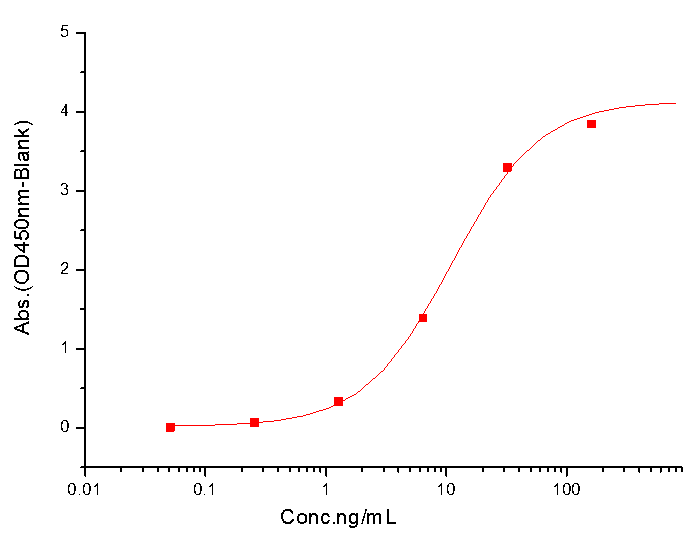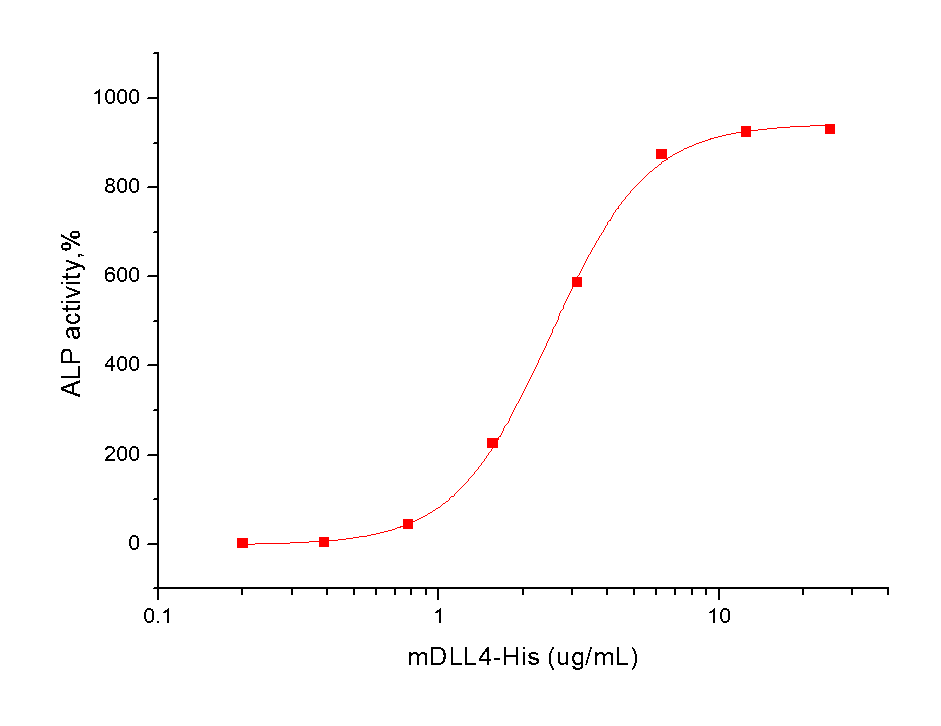购物车
- 全部删除
 您的购物车当前为空
您的购物车当前为空

DLL4 Protein, Mouse, Recombinant (His) is expressed in HEK293 mammalian cells with His tag. The predicted molecular weight is 55.7 kDa and the accession number is Q9JI71.

| 规格 | 价格 | 库存 | 数量 |
|---|---|---|---|
| 100 μg | ¥ 3,820 | 现货 | |
| 200 μg | ¥ 6,750 | 5日内发货 | |
| 500 μg | ¥ 14,280 | 5日内发货 |
| 生物活性 | 1. Immobilized DLL4 Protein, Mouse, Recombinant (His Tag) at 2 μg/mL (100 μL/well) can bind NOTCH1 Protein, Mouse, Recombinant (ECD, hFc Tag), the EC50 is 5-30 ng/mL.
2. Measured by the ability of the immobilized protein to enhance BMP2-induced alkaline phosphatase activity in C3H10T1/2 mouse embryonic fibroblast cells. The ED50 for this effect is typically 1-5 µg/mL in the presence of 500 ng/mL recombinant human BMP2.   |
| 产品描述 | DLL4 Protein, Mouse, Recombinant (His) is expressed in HEK293 mammalian cells with His tag. The predicted molecular weight is 55.7 kDa and the accession number is Q9JI71. |
| 种属 | Mouse |
| 表达系统 | HEK293 Cells |
| 标签 | C-His |
| 蛋白编号 | Q9JI71 |
| 别名 | δ-like 4 (Drosophila),δ4,Dll4,delta-like 4 (Drosophila),Delta4 |
| 蛋白构建 | A DNA sequence encoding the extracellular domain of mouse DLL4 (NP_062327.2) (Met 1-Pro 525) was expressed, with a C-terminal polyhistidine tag. Predicted N terminal: Ser 28 |
| 蛋白纯度 | > 96 % as determined by SDS-PAGE  |
| 分子量 | 55.7 kDa (predicted); 68 kDa (reducing condition, due to glycosylation) |
| 内毒素 | < 1.0 EU/μg of the protein as determined by the LAL method. |
| 缓冲液 | Lyophilized from a solution filtered through a 0.22 μm filter, containing PBS, pH 7.4. Typically, a mixture containing 5% to 8% trehalose, mannitol, and 0.01% Tween 80 is incorporated as a protective agent before lyophilization. |
| 复溶方法 | A Certificate of Analysis (CoA) containing reconstitution instructions is included with the products. Please refer to the CoA for detailed information. |
| 存储 | It is recommended to store recombinant proteins at -20°C to -80°C for future use. Lyophilized powders can be stably stored for over 12 months, while liquid products can be stored for 6-12 months at -80°C. For reconstituted protein solutions, the solution can be stored at -20°C to -80°C for at least 3 months. Please avoid multiple freeze-thaw cycles and store products in aliquots. |
| 运输方式 | In general, Lyophilized powders are shipping with blue ice. |
| 研究背景 | Delta-like protein 4 (DLL4, Delta4), a type I membrane-bound Notch ligand, is one of five known Notch ligands in mammals and interacts predominantly with Notch 1, which has a key role in vascular development. Recent studies yield substantial insights into the role of DLL4 in angiogenesis. DLL4 is induced by vascular endothelial growth factor (VEGF) and acts downstream of VEGF as a 'brake' on VEGF-induced vessel growth, forming an autoregulatory negative feedback loop inactivating VEGF. DLL4 is downstream of VEGF signaling and its activation triggers a negative feedback that restrains the effects of VEGF. Attenuation of DLL4/Notch signaling results in chaotic vascular network with excessive branching and sprouting. DLL4 is widely distributed in tissues other than vessels including many malignancies. Furthermore, the molecule is internalized on binding its receptor and often transported to the nucleus. In pathological conditions, such as cancer, DLL4 is up-regulated strongly in the tumour vasculature. Blockade of DLL4-mediated Notch signaling strikingly increases nonproductive angiogenesis, but significantly inhibits tumor growth in preclinical mouse models. In preclinical studies, blocking of DLL4/Notch signaling is associated with a paradoxical increase in tumor vessel density, yet causes marked growth inhibition due to functionally defective vasculature. Thus, DLL4 blockade holds promise as an additional strategy for angiogenesis-based cancer therapy. |